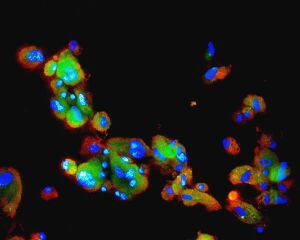Circulating tumor cells
Circulating tumor cells (CTCs) are tumor cells released from a primary tumor or metastasis into the bloodstream. This makes them part of the process of hematogenous spread. Tumor cells can then settle in various organs and initiate metastases. The preference for CTC growth in individual organs is probably in accordance with the so-called "seed and soil" hypothesis according to S. Paget.[1] CTCs are a prognostic and predictive biomarker, now also diagnostic and pharmacodynamic (monitoring the response to treatment).
CTC isolation and detection[edit | edit source]
CTCs are standardly isolated from peripheral blood (non-coagulating) using various separation methods, most often based on the expression of surface markers (eg EpCAM) and the physical properties of CTC (eg size, deformability, ...). The advantage of cell size separation is that the cells are isolated live and can be cultured in vitro for further cellular and molecular analysis. Based on standardized fluorescence stains, it is then possible to perform cytomorphological analysis and determine the number of CTCs present in the examined blood volume. In the case of the possibility of comparing more samples, it is possible to define whether the disease has a progressive or regressive trend. The first collection is performed before the start of therapy, the next during or after the end of therapy. The viability of isolated CTCs is also a prerequisite for molecular analysis - eg gene expression analysis (isolation of RNA from living cells). Gene expression provides information on both tumor-associated and chemoresistance-associated genes. The information can then be used to optimize the treatment process for individual patients. Similarly, it is then possible to test DNA and create a personalized mutation profile for patients based on sequencing analysis.
Use[edit | edit source]
The clinical implementation of CTC examinations is not yet officially supported by international companies (ASCO, ESMO), but the methods for CTC analysis are constantly improving and it is therefore possible to expect their clinical use in the personalization of cancer treatment. An undeniable advantage of CTC testing is the fact that blood collection is a relatively non-invasive method compared to tumor biopsy.
Links[edit | edit source]
Related articles[edit | edit source]
Source[edit | edit source]
- MOHAN, Sumitra, Francesca CHEMI a Ged BRADY. Challenges and unanswered questions for the next decade of circulating tumour cell research in lung cancer. Translational Lung Cancer Research. 2017, roč. 4, vol. 6, s. 454-472, ISSN 2226-4477. DOI: 10.21037/tlcr.2017.06.04.
- ZHANG, Zhuo, Nithya RAMNATH a Sunitha NAGRATH. Current status of CTCs as liquid biopsy in lung cancer and future directions. Frontiers in Oncology. 2015, roč. 5, vol. 209, s. ?, ISSN 2234-943X. DOI: 10.3389/fonc.2015.00209.
References[edit | edit source]
- ↑ ROBERT, Langley, et al. The seed and soil hypothesis revisited - the role of tumor-stroma interactions in metastasis to different organs [online]. [cit. 2017-10-30]. <https://www.ncbi.nlm.nih.gov/pmc/articles/PMC3075088/>.

